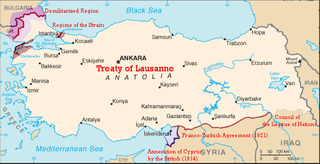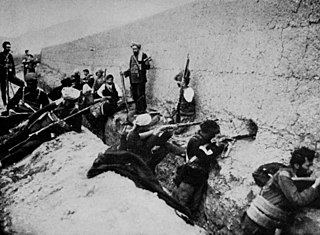Related Research Articles

The Treaty of Lausanne is a peace treaty negotiated during the Lausanne Conference of 1922–23 and signed in the Palais de Rumine in Lausanne, Switzerland, on 24 July 1923. The treaty officially resolved the conflict that had initially arisen between the Ottoman Empire and the Allied French Republic, British Empire, Kingdom of Italy, Empire of Japan, Kingdom of Greece, Kingdom of Serbia, and the Kingdom of Romania since the outset of World War I. The original text of the treaty is in French. It emerged as a second attempt at peace after the failed and unratified Treaty of Sèvres, which had sought to partition Ottoman territories. The earlier treaty, signed in 1920, was later rejected by the Turkish National Movement which actively opposed its terms. As a result of the Greco-Turkish War, Izmir was reclaimed, and the Armistice of Mudanya was signed in October 1922. This armistice provided for the exchange of Greek-Turkish populations and allowed unrestricted civilian, non-military passage through the Turkish Straits.

The Adana massacre occurred in the Adana Vilayet of the Ottoman Empire in April 1909. A massacre of Armenian Christians by Ottoman Muslims in the city of Adana amidst the Ottoman countercoup of 1909 expanded to a series of anti-Armenian pogroms throughout the province. Around 20,000 to 25,000 people were killed in Adana and surrounding towns, mostly Armenians; it was reported that about 1,300 Assyrians were also killed during the massacres. Unlike the earlier Hamidian massacres, the events were not organized by the central government but instead instigated by local officials, intellectuals, and Islamic clerics, including Committee of Union and Progress (CUP) supporters in Adana. Professor of History Ronald Grigor Suny from the University of Michigan describes Adana as "more like an urban riot that degenerated into a pogrom rather than a state-initiated mass killing".

The Young Turk Revolution was a constitutionalist revolution in the Ottoman Empire. The Committee of Union and Progress (CUP), an organization of the Young Turks movement, forced Sultan Abdul Hamid II to restore the Ottoman Constitution and recall the parliament, which ushered in multi-party politics within the Empire. From the Young Turk Revolution to the Empire's end marks the Second Constitutional Era of the Ottoman Empire's history. More than three decades earlier, in 1876, constitutional monarchy had been established under Abdul Hamid during a period of time known as the First Constitutional Era, which lasted for only two years before Abdul Hamid suspended it and restored autocratic powers to himself.

Ahmed Rıza was an Ottoman politician, educator, and a prominent member of the Young Turks, during the Second Constitutional Era of the Ottoman Empire. He was also a key early leader of the Committee of Union and Progress.

The Urfa resistance was an effort by some Ottoman Armenians in Urfa to defend themselves against the Armenian genocide launched by the Ottoman Empire. The resistance was quelled following German intervention.

Armenian resistance included military, political, and humanitarian efforts to counter Ottoman forces and mitigate the Armenian genocide during the first World War. Early in World War I, the Ottoman Empire commenced efforts to eradicate Armenian culture and eliminate Armenian life, through acts of killing and death marches into uninhabitable deserts and mountain regions. The result was the homogenisation of the Ottoman Empire and elimination of 90% of the Armenian Ottoman population.
The University of Utah Press is the independent publishing branch of the University of Utah and is a division of the J. Willard Marriott Library. Founded in 1949 by A. Ray Olpin, it is also the oldest university press in Utah. The mission of the press is to "publish and disseminate scholarly books in selected fields, as well as other printed and recorded materials of significance to Utah, the region, the country, and the world."
Ronald Grigor Suny is an American historian and political scientist. Suny is the William H. Sewell Jr. Distinguished University Professor of History at the University of Michigan and served as director of the Eisenberg Institute for Historical Studies, 2009 to 2012 and was the Charles Tilly Collegiate Professor of Social and Political History at the University of Michigan from 2005 to 2015, and is Emeritus Professor of political science and history at the University of Chicago.
Ra's al-'Ayn camps were desert death camps near Ra's al-'Ayn city, where many Armenians were deported and slaughtered during the Armenian genocide. The site became "synonymous with Armenian suffering".

Sürgün or verb form sürmek was a practice within the Ottoman Empire that entailed the movement of a large group of people from one region to another, often a form of forced migration imposed by state policy or international authority. The practice was also a form of banishment or exile often applied to the elites of Ottoman society, the Pashas. It was most famously used as a method to forcefully displace the native ethnic Armenians by the Young Turk government in 1915, in order to deal with a perceived threat from Armenian partisan groups receiving military support from the, Ottoman hostile, Russian Empire. These events are listed as one of the methods used to complete the Armenian Genocide.

"They Can Live in the Desert but Nowhere Else": A History of the Armenian Genocide is a book by Ronald Grigor Suny about the Armenian genocide, published by Princeton University Press in 2015. The book was praised as an accessible work that provides the academic consensus on why and how the Armenian genocide occurred.

During World War I, Imperial Germany was a military ally of the Ottoman Empire, which perpetrated the Armenian genocide. Many Germans present in eastern and southern Anatolia witnessed the genocide, but censorship and self-censorship hampered these reports, while German newspapers reported Turkish denial of the massacres. About 800 Imperial German Army officers and 25.000 German soldiers were an integral part of the Turkish army and belonged to its command and general staff. It is known that individual German military advisors signed some of the orders that led to deportations of Armenians. Although many individual German people tried to publicize the Armenians' fate in defiance of wartime censorship or to save as many lives as possible, the German Foreign Office and Ministry of War have both been harshly criticized for "extreme moral indifference" to the plight of Armenians and not doing more to stop the genocide. In 2016, the Bundestag apologized for Germany's "inglorious role" in a resolution recognizing the genocide.
The Workshop for Armenian/Turkish Scholarship (WATS) is a group of scholars which is dedicated to transcending the nationalist historiography on the Armenian genocide and answering related questions. It first met in 2000. The workshop and the book it published were widely praised as first-class scholarship that significantly advanced the field. According to the workshop organizers, Turkish participants have faced state harassment for their participation.

Pro Armenia (1900–1914) was a French-language fortnightly that took pro-Armenian positions. The goal of the journal was to raise awareness in Europe about the plight of Armenians in the Ottoman Empire. It was founded at the initiative of Christapor Mikaelian, a co-founder of the Armenian Revolutionary Federation, enlisting the help of a number of prominent Dreyfusard and leftist intellectuals. Pierre Quillard was its editor-in-chief and Jean Longuet was its secretary. The members of its editorial committee were Georges Clemenceau, Anatole France, Jean Jaurès, Francis de Pressensé, and Edmond de Roberty. It temporarily ceased publication after the 1908 Ottoman constitutional revolution. It was published again in 1912 and 1913 under the title Pour les Peuples d’Orient. In 1914, the last year that the journal was published, it resumed its original name.

The 1914 Greek deportations was the forcible expulsion of around 150,000 to 300,000 Ottoman Greeks from Eastern Thrace and the Aegean coast of Anatolia by the Committee of Union and Progress that culminated in May and June 1914. The deportations almost caused war between Greece and the Ottoman Empire and were an important precursor to the Armenian genocide.

On 24 May 1915, on the initiative of Russia, the Triple Entente—Russia, France, and the United Kingdom—issued a declaration condemning the ongoing Armenian genocide carried out in the Ottoman Empire and threatening to hold the perpetrators accountable. This was the first use of the phrase "crimes against humanity" in international diplomacy, which later became a category of international criminal law after World War II.

Differing views of what caused the Armenian genocide include explanations focusing on nationalism, religion, and wartime radicalization and continue to be debated among scholars. In the twenty-first century, focus has shifted to multicausal explanations. Most historians agree that the genocide was not premeditated before World War I, but the role of contingency, ideology, and long-term structural factors in causing the genocide continues to be discussed.

In 1915, a systematic anti-Christian genocide was committed in Diyarbekir vilayet, claiming the lives of most Armenians, Syriac Christians, Greek Orthodox, and Greek Catholics living there. The genocide was ordered by governor Mehmed Reshid, partly with the backing of the CUP Central Committee.
During the Armenian Genocide, when 1.5 million Armenians were killed between 1915 and 1917, many Turkish civilians, politicians and military leaders refused to participate in the massacres and looting and tried to stop the deportation and massacre of Armenians. Many of these people lost their positions as a result of their actions, and some were killed.
References
- ↑ Suny, Ronald Grigor (2015). "They Can Live in the Desert but Nowhere Else": A History of the Armenian Genocide. Princeton University Press. p. 48. ISBN 978-1-4008-6558-1.
- ↑ Suny, Ronald Grigor (2015). "They can live in the desert but nowhere else" : a history of the Armenian genocide. Princeton. p. 48. ISBN 978-1-4008-6558-1. OCLC 903685759.
{{cite book}}: CS1 maint: location missing publisher (link) - 1 2 Sharkey, Heather J. (2017). A history of Muslims, Christians, and Jews in the Middle East. Cambridge, United Kingdom. p. 85. ISBN 978-0-521-76937-2. OCLC 995805601.
{{cite book}}: CS1 maint: location missing publisher (link) - ↑ ed., Greene, Molly. (2013). Minorities in the Ottoman Empire. Markus Wiener Publishers. p. 47. ISBN 978-1-55876-228-2. OCLC 1154080153.
{{cite book}}:|last=has generic name (help)CS1 maint: multiple names: authors list (link)